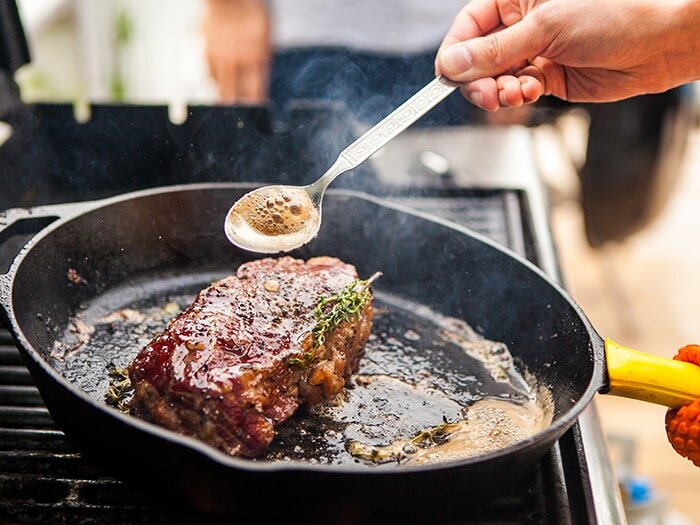Cast iron cookware has proven itself over time to be versatile, long-lasting, economical and also cook foods differently, often better, than stainless, non-stick or other options. Here are some facts about cast iron and reasons why you may want to use it too.
 The first recorded use of cast iron cookware was during the Han Dynasty in China around 220 AD. When the knowledge and techniques for casting became more widespread, cast iron cookware became popular across Europe in the 16th century. Since then, it’s become a staple in many kitchens across the globe; and for good reason.
In 1707, Abraham Darby is credited with coming up with a method of casting iron pots and kettles that were thinner than previously made. This made them cheaper to produce and easier to use.
Cast iron cookware has proven itself over time to be versatile, long-lasting, economical and also cook foods differently, often better, than stainless, non-stick or other options. If you are thinking of starting to join the cast iron fan club, here are some quick benefits, challenges and myths about this great time-tested workhorse.
The first recorded use of cast iron cookware was during the Han Dynasty in China around 220 AD. When the knowledge and techniques for casting became more widespread, cast iron cookware became popular across Europe in the 16th century. Since then, it’s become a staple in many kitchens across the globe; and for good reason.
In 1707, Abraham Darby is credited with coming up with a method of casting iron pots and kettles that were thinner than previously made. This made them cheaper to produce and easier to use.
Cast iron cookware has proven itself over time to be versatile, long-lasting, economical and also cook foods differently, often better, than stainless, non-stick or other options. If you are thinking of starting to join the cast iron fan club, here are some quick benefits, challenges and myths about this great time-tested workhorse.
Benefits
- Quick and Easy Cleaning
- No “non-stick” surface to wear or scrape off into food
- No harmful fumes (like some non-stick) released if heated past a certain temperature
- Reliable and long-lasting
- Versatility- from searing meat and potatoes to baking cookies and pizza
- Maintains heat
- Relatively low cost
- Non-toxic and Non-stick
- Seasoned cast iron eliminates the need for more oil or butter which can mean less fat in your food.
- Looks great for serving and holds heat for hot dishes longer
Challenges
- Cooking acidic foods like Tomatoes or citrus juices can pull iron from the pan. Although not harmful it can turn your foods darker and if acidic foods are left in the pan it can break down the seasoning and lead to rust.
Considerations
- When cleaning, use a mild soap and hot water. Use a scrubber for convenience like Lodge’s scrubbing bristle brush for cast iron.

Myths
- Even heat distribution. In actuality, cast iron doesn’t distribute heat but get’s hot spots directly above the heat source. Its conductivity is about 1/3 to 1/4 of a material like aluminum. The real advantage is that cast iron DOES maintain heat once it’s hot. That is why it’s so great at searing meat- consistent heat application to the meat surface. Another advantage of cast iron is that it has a very high heat emissivity level- the amount of heat energy expelled in the form of radiated heat. Compared to stainless steel, cast iron’s emissivity rating is over 9 times higher. That means it’s cooking beyond just the surface of the pan or skillet.
- Cast iron is totally non-stick. While a well-seasoned cast iron utensil that is preheated before adding food for cooking is very non-stick. It in no way approaches that of things like Teflon. Seasoning is not a thin layer of oil that will easily rinse off with soap. It's a thin layer of polymerized oil. In well-seasoned cast iron, the oil has already broken down into a substance that has bonded to the surface of the metal. That’s what gives it non-stick properties, and because the material is no longer actually an oil, the chemicals in dish soap designed to remove oils should not affect it. Soap it and scrub it out! (Just remember to dry right away and re-season).
- Don’t use metal utensils with cast iron. Cast iron is tough and the seasoning doesn’t just scrape off. It’s bonded to the metal. It’s possible to experience some scaling over time, but that is usually baked-on food particles that haven’t been cleaned off. Unless you are really gouging and pounding at the metal, using metal spatulas and spoons is just fine in your cast iron pan.
We would love to see your Cast Iron Cooking, use #mywilcolife on Facebook, Twitter, or Instagram and tag Wilco Stores.
Orders
Services
About
Your Wilco Store
Store Hours
Monday to Saturday:
8 a.m. to 8 p.m.
Sunday: 9 a.m. to 6 p.m.
Need Help?
For questions or help with online orders call: (888) 78-WILCO
Limited to stock on hand. Some items may vary from photos. Because of store size limitations or geography, some items featured may not be available in all stores but will be made available by special order during sale periods at advertised prices. All sale prices listed as “dollars off” or “% off” are discounted from our regular posted shelf price, not from discounts given with specialty, bulk or pallet pricing. Reseller and Drop-shippers must contact us for pre-approval to place orders with the intent to re-distribute.
© 2025, Wilco Farm Store
